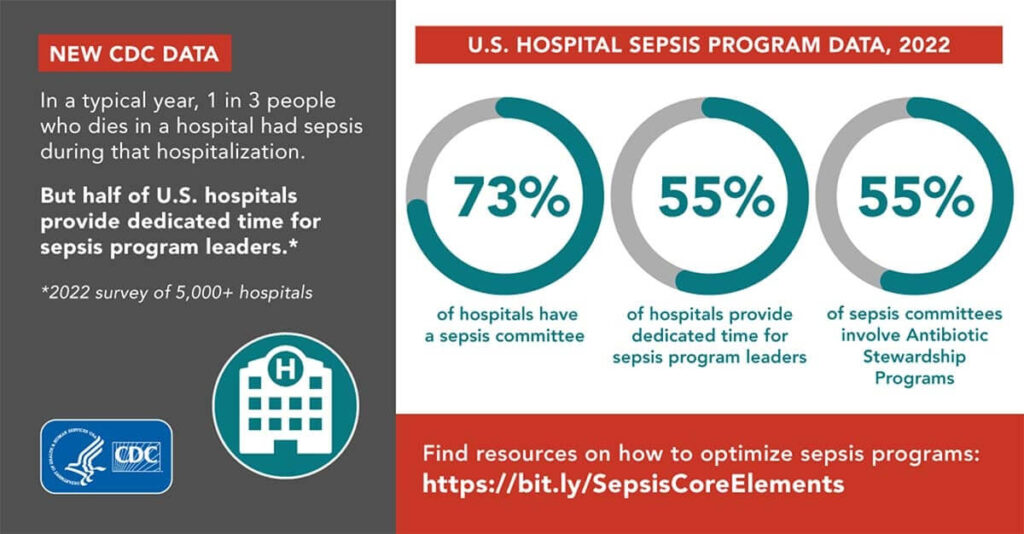
Mega Doctor News
The Centers for Disease Control and Prevention (CDC) is launching the Hospital Sepsis Program Core Elements to support all U.S. hospitals in ensuring effective teams and resources are in place to be able to quickly identify sepsis and save more lives. This new, critical resource is intended to help hospitals implement, monitor, and optimize sepsis programs and improve survival rates. CDC’s latest survey of 5,221 hospitals found 73% report having sepsis teams, but only half (55%) report that team leaders are provided with dedicated time to manage sepsis programs.

“Sepsis is taking too many lives. One in three people who dies in a hospital has sepsis during that hospitalization. Rapid diagnosis and immediate appropriate treatment, including antibiotics, are essential to saving lives, yet the challenges of awareness about and recognition of sepsis are enormous. That’s why CDC is calling on all U.S. hospitals to have a sepsis program and raise the bar on sepsis care by incorporating these seven core elements,” said CDC Director Mandy Cohen, M.D., M.P.H. “Seven elements provide an organizational framework and key concepts that guide hospitals as they work to improve early recognition and treatment to save lives.”
Sepsis is the body’s extreme response to an infection. It is a life-threatening condition that requires urgent medical care to prevent tissue damage, organ damage, and death. In a typical year, at least 1.7 million adults in America develop sepsis and at least 350,000 adults who develop sepsis die during their hospitalization or are moved into hospice care. Most adult patients with sepsis (87%) are brought to the hospital with an infection that is not getting better and almost any infection, including COVID-19, influenza, or RSV, can lead to sepsis.
The Sepsis Core Elements are intended to be a “manager’s guide” to organizing staff and identify the resources that will help bring sepsis rates down and survival rates up. Sepsis care is complex. The Sepsis Core Elements approach is an important step to help hospitals structure their sepsis programs to coordinate multiple departments and disciplines and effectively manage the multifaceted care needed. Based on CDC’s 2022 National Healthcare Safety Network Annual Survey of hospitals, only half (55%) report that they integrate Antibiotic Stewardship Programs, for example, to monitor and review antibiotic and antifungal use in sepsis care. This presents an opportunity to improve a vital component of a patient’s successful recovery from sepsis.
Modeled after CDC’s Core Elements of Antibiotic Stewardship, which has proven to be an impactful resource to protect patients from the harms caused by unnecessary antibiotic use and to combat antimicrobial resistance, the Sepsis Core Elements were created with the expectation that all hospitals, regardless of size and location, would benefit from this resource and incorporate the following elements into the foundation of a strong sepsis program:
Leadership Commitment: Dedicating the necessary human, financial, and information technology resources.
Accountability: Appointing a leader responsible for program outcomes and setting concrete program goals.
Multi-professional expertise: Engaging key partners throughout the organization.
Action: Implementing structures and processes to improve the identification of, management of, and recovery from sepsis.
Tracking: Measuring sepsis epidemiology, outcomes, progress toward program goals, and the impact of sepsis initiatives.
Reporting: Providing usable information on sepsis treatment and outcomes to relevant partners.
Education: Providing sepsis education to healthcare professionals during onboarding and annually.
“CDC’s Hospital Sepsis Program Core Elements are a guide for structuring sepsis programs that put your healthcare providers in the best position to rapidly identify and provide effective care for all types of patients with sepsis,” says Raymund Dantes, M.D., MPH, CDC medical advisor. “The seven elements complement clinical guidelines by describing the leadership, expertise, tracking, education, and other elements that can be implemented in a wide variety of hospitals to improve the quality of sepsis care.”
The launch of the Sepsis Core Elements coincides with Sepsis Awareness Month. During the month of September, CDC will provide life-saving educational information to healthcare professionals, patients, families, and caregivers about the importance of preventing infections that can lead to sepsis through its ongoing Get Ahead of Sepsis campaign. CDC will continue to provide materials on recognizing the signs and symptoms of sepsis, when to ACT FAST and get emergency medical care IMMEDIATELY, and when to ask a healthcare provider, “Could this infection be leading to sepsis?” To learn more about sepsis and how to prevent infections, visit www.cdc.gov/sepsis or call 1-800-CDC-INFO.
Information Source: CDC











